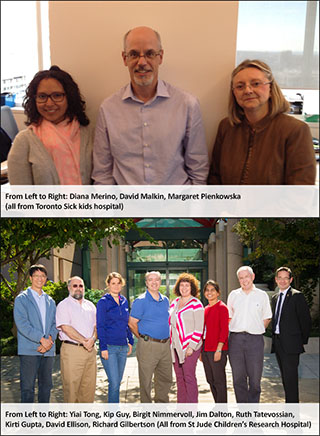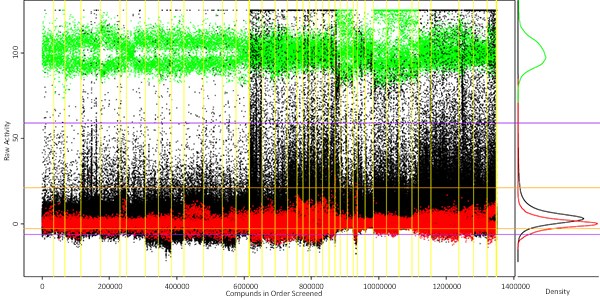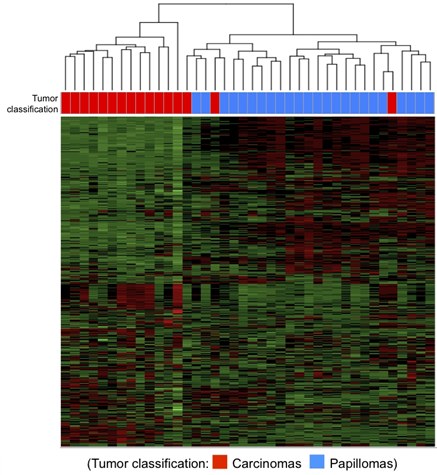


Posted December 12, 2013
Richard Gilbertson, M.D., Ph.D., Rodney Guy, Ph.D., David Ellison, M.D., Ph.D.,
St. Jude's Children's Research Hospital, Memphis, Tennessee, and
David Malkin, M.D., The Hospital for Sick Children, Toronto, Ontario, Canada
 Choroid plexus carcinoma (CPC) is a childhood cancer affecting only 2% of children with brain tumors. Because of its rarity, CPC has not attracted the attention of the research community; there have been no advances in the treatment of this disease over the last 25 years, even though more than half of affected children die within 5 years. In Fiscal Year 2009 (FY09), the Peer Reviewed Cancer Research Program (PRCRP) awarded the single pediatric brain tumor Synergistic Idea Award to the multi-institute applicants from St. Jude's Children Hospital and The Hospital for Sick Children where the researchers, Drs. Richard Gilbertson, Rodney Guy, David Ellison, and David Malkin, are working together to design a new approach to CPC. The multidisciplinary scientific team aims to understand the genetic basis of CPC and to develop novel targeted drug therapies to improve the poor outcome for children with CPC.
Choroid plexus carcinoma (CPC) is a childhood cancer affecting only 2% of children with brain tumors. Because of its rarity, CPC has not attracted the attention of the research community; there have been no advances in the treatment of this disease over the last 25 years, even though more than half of affected children die within 5 years. In Fiscal Year 2009 (FY09), the Peer Reviewed Cancer Research Program (PRCRP) awarded the single pediatric brain tumor Synergistic Idea Award to the multi-institute applicants from St. Jude's Children Hospital and The Hospital for Sick Children where the researchers, Drs. Richard Gilbertson, Rodney Guy, David Ellison, and David Malkin, are working together to design a new approach to CPC. The multidisciplinary scientific team aims to understand the genetic basis of CPC and to develop novel targeted drug therapies to improve the poor outcome for children with CPC.
Both understanding the biology of CPC and generating accurate laboratory models for identifying effective therapies are crucial to advancing treatment for this disease. Recognizing this need and because there are no other studies defining the genetic alterations of these tumors, the researchers decided to examine the DNA and RNA of choroid plexus tumors to identify changes that were unique to each tumor subtype. They have successfully generated the first laboratory model that faithfully recapitulates the human disease and have used the model to screen an extensive collection of compounds to identify those that are potent against CPC.
The research team has, for the first time, defined the molecular landscape of choroid plexus tumors and identified altered genes that drive the progression of CPC. This means each tumor subtype can be categorized according to common genetic alterations, which will improve tumor diagnosis. Furthermore, the identification of genetic alterations will improve the understanding of the mechanisms that are responsible for tumor development and enable the design of therapies that will suppress tumor growth without affecting the healthy tissue around it.
The next step in bringing this research to cancer patients is the identification and development of effective drugs. Screening Food and Drug Administration-approved compounds and compounds in preclinical development, the investigators identified eight candidate compounds for the treatment of CPC, of which gemcitabine is currently in clinical development for CPC patients. In addition, the multidisciplinary team has embarked on the largest academia-based drug screen of 1.2 million compounds for pediatric cancer to identify novel compounds suitable for preclinical development. Validating the safety of drugs through their pharmacological and toxicological studies as well as careful consideration of the administration route and schedule, the clinical team will ensure that the drug suppresses the growth of the tumor, while leaving other normal tissue intact, thus reducing the side effects of chemotherapy.
The strengths and uniqueness of the research team stem from its multidisciplinary approach. There is no other similar team in the world working on understanding the biology of choroid plexus tumors and identifying effective drugs for the clinic with a multi-pronged strategy. The scientists and clinicians of this FY09 PRCRP Synergistic Idea award give hope to CPC patients and their families.

Figure 1: Scatter plot summarizing data from 1.4 million compounds screened against CPC (y-axis) and their activity against CPC (x-axis). Each black dot is a test compound, red dots are negative controls and green dots are positive controls.

Figure 2: Unsupervised hierarchical clustering of 40 CPC patients distinguishes between choroid plexus tumor subtypes.

Figure 3: Fluorescence In-Situ Hybridization (FISH) of human choroid plexus tumor samples reveals gains in Chromosome 1. CPC cells show amplification of RAD54L gene which is located on chromosome 1p (green color).
Links:
Public and Technical Abstracts: Molecular-Targeted Therapies of Childhood Choriod Plexus Carcinoma














